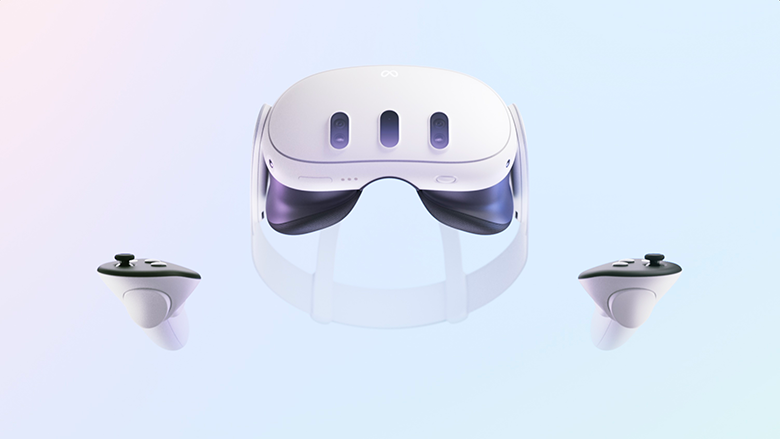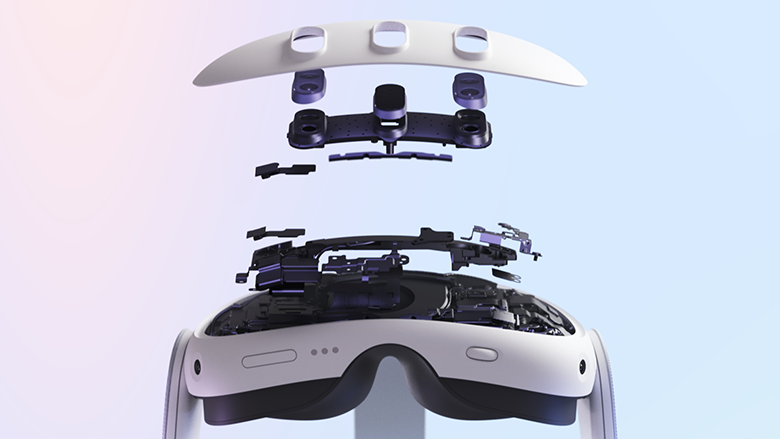In Virtual Reality and Mixed Reality News
June 2, 2023 – This week, Mark Zuckerberg announced Meta’s next-generation virtual and mixed reality headset – the Meta Quest 3, which launches later this year. According to Meta, it features higher resolution, stronger performance, breakthrough Meta Reality technology, and a slimmer, more comfortable form factor.
With an announcement from Apple regarding an XR device seeming extremely likely in the coming days, it seems as if Meta is trying to dampen the fanfare of any potential announcement, and also likely position itself as the most affordable option for users to enter the virtual and mixed reality (VR/MR) space.
Quest 3 will ship in all countries where Meta Quest is currently supported this fall. The 128GB headset starts at USD $499.99, and the company is offering an additional storage option for users who want some extra space. Meta noted that it will have lots more to share at its Meta Connect event, which returns this year on September 27.

Meta’s Most Powerful Headset Yet
Meta stated that the new Quest 3 device will combine the company’s highest resolution display yet and pancake optics. To power the extra pixels, this will be the first headset to feature a next-generation Snapdragon chipset developed in collaboration with Qualcomm Technologies. This next-gen Snapdragon chipset will deliver more than twice the graphical performance as the previous generation Snapdragon GPU in Quest 2, which is currently powered by Qualcomm’s XR2 chipset. Again, Meta noted that more details on the chipset that’s powering Quest 3 will be unveiled later this year.

Immersive VR + Meta Reality technology on Quest 3
On Quest 3, Meta Reality technology will allow for the seamless blending of the physical and virtual worlds. According to Meta, new experiences on the device will “go beyond today’s mixed reality by intelligently understanding and responding to objects in a user’s physical space” and will allow users to navigate that space in natural, intuitive ways that were nearly impossible before.
High-fidelity color Passthrough, machine learning, and spatial understanding let users interact with virtual content and the physical world simultaneously, creating limitless possibilities to explore.
The Quest 3 will apparently feature dual 4MP RGB color cameras, a depth sensor for a more accurate representation of the play space, and 10x more pixels in Passthrough compared to the Quest 2 device.
Meta stated in its announcement: “In other words: Quest 3 is our first mass-market offering to deliver both cutting-edge VR and MR experiences in a single device, setting a new benchmark for future headsets.”

The company’s VP of VR, Mark Rabkin, commented: “Ultimately, our vision is to enable you to move through all realities in a way that’s intuitive and delightful, going beyond the rigid classifications of ‘virtual reality’ and ‘mixed reality’ to deliver truly next-gen experiences that let you effortlessly blend the physical and virtual worlds. Meta Reality gives you both the deep, immersive magic of VR and the freedom and delight of making your physical world more fun and useful with MR.”
Design
With a 40% slimmer optic profile* compared to Quest 2, Quest 3 is a sleeker, more comfortable headset. Meta has also completely redesigned Quest 3’s Touch Plus controllers with a more streamlined and ergonomic form factor. Thanks to the company’s advances in tracking technology, Meta has dropped the outer tracking rings so the controllers feel like a more natural extension of a user’s hands and take up less space.
Meta has also included TruTouch haptics that first debuted in Touch Pro. Users can also upgrade to Meta’s fully self-tracked Meta Quest Touch Pro Controllers for a premium experience.Hand tracking will also be supported out of the box, allowing users to explore without controllers, thanks to the device’s Direct Touch technology.

Content
The Quest 3 is backwards compatible with the Quest 2 catalog of over 500 VR games, apps, and experiences, and Meta stated that it has even more new VR and MR titles lined up for launch.

What about Quest 2?
As for the Meta Quest 2 headset, it is still currently one of the most affordable ways to get into VR, and starting June 4, the price of the device will be lowering just USD $299.99 for the 128GB SKU and USD $349.99 for the 256GB SKU.
In an upcoming software update, the company will also be updating the Quest 2 and Quest Pro GPU and CPU. Quest 2 and Pro will see an up-to 26% CPU performance increase with an up-to 19% GPU speed increase for Quest 2 and 11% for Quest Pro, according to Meta. The company noted that the update should result in smoother gameplay, a more responsive UI, and richer content on both headsets. Plus, the company is enabling Dynamic Resolution Scaling for both Quest 2 and Quest Pro, so games and apps can take advantage of increased pixel density without dropping frames.
Meta closed its announcement by stated that while the new Quest 3 will set a new standard for mixed reality, immersive gaming, and what a mainstream VR headset can be, Quest 2 will remain the company’s most affordable entry point to VR, and the Quest Pro is optimized for work use cases, with face and eye tracking for more authentic self-expression in meetings. The Quest 2 and Quest Pro devices will as a result continue to be sold alongside Quest 3 when it is released, and new software updates will continue to be shipped to make the Quest experience even better.
For more information on the Quest 3, click here.
Image / video credit: Meta / YouTube
About the author
Sam is the Founder and Managing Editor of Auganix. With a background in research and report writing, he has been covering XR industry news for the past seven years.




